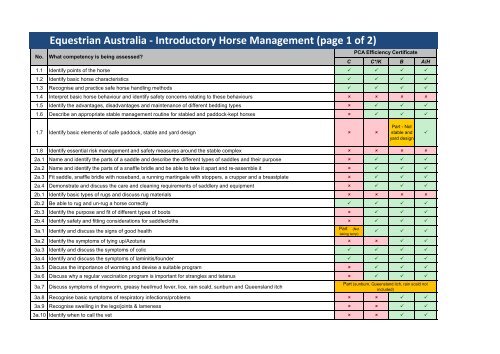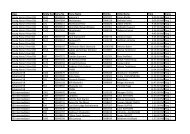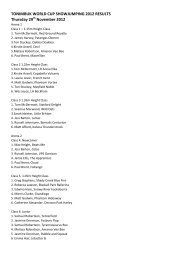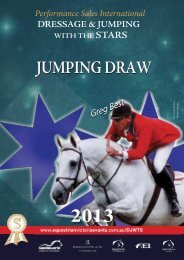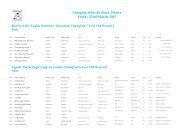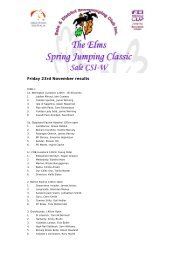Equestrian Australia - Introductory Horse Management (page 1 of 2)
Equestrian Australia - Introductory Horse Management (page 1 of 2)
Equestrian Australia - Introductory Horse Management (page 1 of 2)
You also want an ePaper? Increase the reach of your titles
YUMPU automatically turns print PDFs into web optimized ePapers that Google loves.
<strong>Equestrian</strong> <strong>Australia</strong> - <strong>Introductory</strong> <strong>Horse</strong> <strong>Management</strong> (<strong>page</strong> 1 <strong>of</strong> 2)<br />
No. What competency is being assessed?<br />
PCA Efficiency Certificate<br />
C C*/K B A/H<br />
1.1 Identify points <strong>of</strong> the horse <br />
1.2 Identify basic horse characteristics <br />
1.3 Recognise and practice safe horse handling methods <br />
1.4 Interpret basic horse behaviour and identify safety concerns relating to these behaviours <br />
1.5 Identify the advantages, disadvantages and maintenance <strong>of</strong> different bedding types <br />
1.6 Describe an appropriate stable management routine for stabled and paddock-kept horses <br />
1.7 Identify basic elements <strong>of</strong> safe paddock, stable and yard design <br />
Part - Not<br />
stable and<br />
yard design<br />
<br />
1.8 Identify essential risk management and safety measures around the stable complex <br />
2a.1 Name and identify the parts <strong>of</strong> a saddle and describe the different types <strong>of</strong> saddles and their purpose <br />
2a.2 Name and identify the parts <strong>of</strong> a snaffle bridle and be able to take it apart and re-assemble it <br />
2a.3 Fit saddle, snaffle bridle with noseband, a running martingale with stoppers, a crupper and a breastplate <br />
2a.4 Demonstrate and discuss the care and cleaning requirements <strong>of</strong> saddlery and equipment <br />
2b.1 Identify basic types <strong>of</strong> rugs and discuss rug materials <br />
2b.2 Be able to rug and un-rug a horse correctly <br />
2b.3 Identify the purpose and fit <strong>of</strong> different types <strong>of</strong> boots <br />
2b.4 Identify safety and fitting considerations for saddlecloths <br />
3a.1 Identify and discuss the signs <strong>of</strong> good health<br />
Part<br />
(Not<br />
taking temp)<br />
<br />
3a.2 Identify the symptoms <strong>of</strong> tying up/Azoturia <br />
3a.3 Identify and discuss the symptoms <strong>of</strong> colic <br />
3a.4 Identify and discuss the symptoms <strong>of</strong> laminitis/founder <br />
3a.5 Discuss the importance <strong>of</strong> worming and devise a suitable program <br />
3a.6 Discuss why a regular vaccination program is important for strangles and tetanus <br />
3a.7 Discuss symptoms <strong>of</strong> ringworm, greasy heel/mud fever, lice, rain scald, sunburn and Queensland itch<br />
Part (sunburn, Queensland itch, rain scald not<br />
included)<br />
3a.8 Recognise basic symptoms <strong>of</strong> respiratory infections/problems <br />
3a.9 Recognise swelling in the legs/joints & lameness <br />
3a.10 Identify when to call the vet
<strong>Equestrian</strong> <strong>Australia</strong> - <strong>Introductory</strong> <strong>Horse</strong> <strong>Management</strong> (<strong>page</strong> 2 <strong>of</strong> 2)<br />
3b.1 Identify the 11 rules <strong>of</strong> feeding <br />
3b.2 Recognise common feed types and their basic properties <br />
3b.3 Identify and discuss poor quality or spoiled feed <br />
3b.4 Recognise common poisonous weeds <br />
3b.5 Discuss the correct storage <strong>of</strong> feed <br />
3b.6 Recognise good and bad paddock feed and understand basic paddock management <br />
Part<br />
(good/bad<br />
paddock)<br />
<br />
<br />
3b.7 Discuss the use <strong>of</strong> hay nets <br />
3c.1 Safely pick up, handle and clean all four hooves <strong>of</strong> the horse <br />
3c.2 Identify the exterior parts <strong>of</strong> the ho<strong>of</strong> <br />
3c.3 Recognise the need for shoeing and understand the basic process <br />
3c.4 Understand the care <strong>of</strong> the horse’s hooves <br />
3c.5 Assess, discuss the physical and visual value <strong>of</strong> grooming a horse <br />
3c.6 Identify and demonstrate the use <strong>of</strong> common grooming equipment <br />
3c.7 Describe correct horse washing techniques <br />
3c.8 Be aware <strong>of</strong> all safety considerations related to horse grooming activities <br />
3c.9 Prepare a horse for travelling a short distance <br />
42 Total Competencies (EA) Competencies met by PCA Course 12 29 36 38<br />
29% 69% 86% 90%<br />
Key for Assessment <strong>of</strong> Equivalent Training<br />
This competency is not covered in the course the candidate has already completed. It will need to be assessed in its entirety<br />
This competency is covered in the course the candidate has already completed, it does not need to be assessed.<br />
Part This competency has been covered in PART in the course the candidate has already completed. Only some will need to be assessed.


